|
|
|
|
|
Surf Fishing 101
|
|
|
|
|
|
|
|
The beaches along the Space Coast can be
divided into several different sections
based on the "topography" of each area.
Starting at the North end, Canaveral
National Seashore stretches from just
south of New Smyrna Beach south to Port
Canaveral and has a sandy bottom. It can
be accessed from New Smyrna Beach on the
North end and from Titusville on the
south end at Playalinda Beach. From
Playalinda Beach south to Port Canaveral
is off limits due to NASA and Canaveral
Air Force Station. A trough generally
forms just offshore of the shorebreak,
followed by a sandbar and then deeper
waters. South of Port Canaveral are the
towns of Cape Canaveral and Cocoa Beach.
Here the bottom is again sandy but slope
of the beach into the water is shallower
and does not form as pronounced of a
trough. This is likely due to the
jetties of Port Canaveral interrupting
natural sand flow. From Patrick Air
Force Base south to about the Town of
Indialantic, there are coquina ridges
and attached to some of these reeflike
structures are
Sabellariid Worm Reefs made up
of colonies of Sabellariid Worms. Around
Indialantic, the reef structures give
way to sand only beaches. From here
south through Melbourne Beach to
Sebastain Inlet the trough here is very
pronounced and afer the first sandbar
the water gets deeper. |
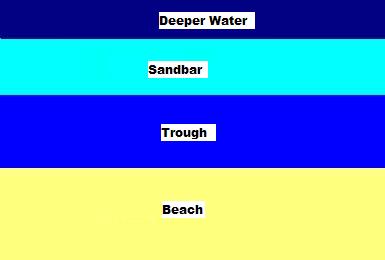 Fishing
the Trough; The trough that forms
between the shorebreak and the first
sandbar runs along the beach like a fish
super highway. You can see it high tide
with enough wave action. As a wave
approaches the sandbar it will grow
steeper, then break over the bar. After
it breaks on the bar it will reform and
the foam will be reduced. The wave will
then break upon the beach. As the wave
breaks it dislodges small invertibrates
such as sand fleas and other small
organisms from the sand and washes them
into the trough. Whiting, croakers
pompano and other species will swim
along the trough searching for these
food sources. In fact if you watch
closely, you will see juvenile whiting
and pompano swimming up onto the beach
to quickly feed with the wave, then
scurry back to the trough as the water
recedes. Glass minnows and mullet will
also swim through the trough. The
presence of these fish will then draw
larger gamfish like snook, which love
croakers, bluefish and sometimes spanish
mackerel. During calmer days this area
can be effectivly fished with lighter
tackle in the 8-12 # range as mentioned
on the Basic Surf ackle page. Higher
tides are the best time. At lower tides,
particularly at Canaveral Seashore, the
trough becomes generally too shallow to
fish. Fishing
the Trough; The trough that forms
between the shorebreak and the first
sandbar runs along the beach like a fish
super highway. You can see it high tide
with enough wave action. As a wave
approaches the sandbar it will grow
steeper, then break over the bar. After
it breaks on the bar it will reform and
the foam will be reduced. The wave will
then break upon the beach. As the wave
breaks it dislodges small invertibrates
such as sand fleas and other small
organisms from the sand and washes them
into the trough. Whiting, croakers
pompano and other species will swim
along the trough searching for these
food sources. In fact if you watch
closely, you will see juvenile whiting
and pompano swimming up onto the beach
to quickly feed with the wave, then
scurry back to the trough as the water
recedes. Glass minnows and mullet will
also swim through the trough. The
presence of these fish will then draw
larger gamfish like snook, which love
croakers, bluefish and sometimes spanish
mackerel. During calmer days this area
can be effectivly fished with lighter
tackle in the 8-12 # range as mentioned
on the Basic Surf ackle page. Higher
tides are the best time. At lower tides,
particularly at Canaveral Seashore, the
trough becomes generally too shallow to
fish. |
|
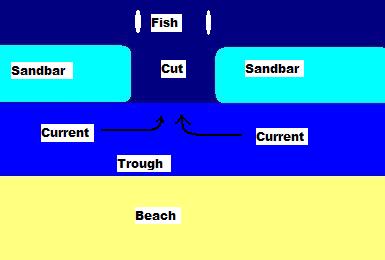 Rips;
A rip current occurs when wave
action forces large quantities of water
over the nearshore sandbar into beach
which flows back into the trough afetr
the wave breaks and the water receeds
into the trough. As the shallows of the
bar prevent the water from flowing back
out to sea as fast as it is coming in
the pressure grows inside the trough
until it forces a break in the sandbar.
When this happens, water will begin
flowing parallel to the beach towards
the cut and by the time it reaches the
cut a large quantity of water will a
"rip" current flowing through the cut
into the deeper water beyond the
sandbar.
For swimmers, this can be a very
dangerous situation as explained below,
but for surf fishers it can be a
goldmine. Those same waves that are
pushing all of this water over the bar
and crashing on the beach are also
dislodging sand fleas and other small
invertibrates out of the sand and
disorienting small fish. The currents
sweep these baits towards the rip
current and out the cut. Predatory fish
will wait along the edges and just
outside of the cut and feed. Rips;
A rip current occurs when wave
action forces large quantities of water
over the nearshore sandbar into beach
which flows back into the trough afetr
the wave breaks and the water receeds
into the trough. As the shallows of the
bar prevent the water from flowing back
out to sea as fast as it is coming in
the pressure grows inside the trough
until it forces a break in the sandbar.
When this happens, water will begin
flowing parallel to the beach towards
the cut and by the time it reaches the
cut a large quantity of water will a
"rip" current flowing through the cut
into the deeper water beyond the
sandbar.
For swimmers, this can be a very
dangerous situation as explained below,
but for surf fishers it can be a
goldmine. Those same waves that are
pushing all of this water over the bar
and crashing on the beach are also
dislodging sand fleas and other small
invertibrates out of the sand and
disorienting small fish. The currents
sweep these baits towards the rip
current and out the cut. Predatory fish
will wait along the edges and just
outside of the cut and feed.
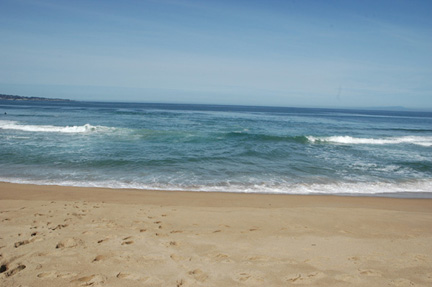 By
observing the waves as they come in, rip
currents can be fairly easy to identify
as waves do react to rips In this photo,
the rip current has slowed the section
of the wave over the rip. This combined
with the deeper area of the cut has also
prevented it from breaking and robbed if
of its energy while the sections of the
wave to either side are breaking. Also
observe the foam left over from breaking
wave in the trough. It will float
parallel along the beach with the side
current until it reaches the rip, then
head out. Also this area will sometimes
look just a bit choppier. In the aerial
photo just below, made available to the
public domain by the National Weather
Service you can clearly see the surface
foam, and in this case sand being washed
to sea by a strong rip current. Again,
these are for fishing, not swimming, and
do not attempt to wade fish in a rip.
Stay on the beach. I've cast pompano
jigs into these and let the current
carry the lure out. It works. By
observing the waves as they come in, rip
currents can be fairly easy to identify
as waves do react to rips In this photo,
the rip current has slowed the section
of the wave over the rip. This combined
with the deeper area of the cut has also
prevented it from breaking and robbed if
of its energy while the sections of the
wave to either side are breaking. Also
observe the foam left over from breaking
wave in the trough. It will float
parallel along the beach with the side
current until it reaches the rip, then
head out. Also this area will sometimes
look just a bit choppier. In the aerial
photo just below, made available to the
public domain by the National Weather
Service you can clearly see the surface
foam, and in this case sand being washed
to sea by a strong rip current. Again,
these are for fishing, not swimming, and
do not attempt to wade fish in a rip.
Stay on the beach. I've cast pompano
jigs into these and let the current
carry the lure out. It works.
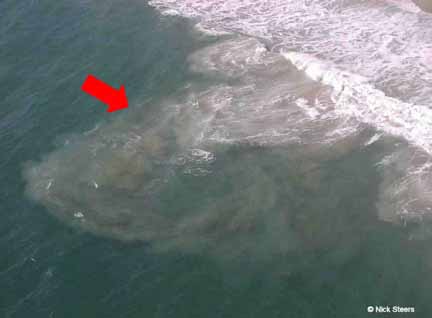 Warning;
If swimming and you find yourself caught
in a rip, do not attempt to swim against
this current towards the shore. It will
be too powerful. Swim parallel to the
beach until you get to one side of the
rip, then head towards shore. Warning;
If swimming and you find yourself caught
in a rip, do not attempt to swim against
this current towards the shore. It will
be too powerful. Swim parallel to the
beach until you get to one side of the
rip, then head towards shore.
Here is a link to an article on rip
current safety. This is important,
especially if you bring the kids fishing
or just to the beach. I may seem to be
harping on this but that is because of
an incident that happened to me while
fishing. I had identified a fairly minor
rip current and was fishing it at
Playalinda Beach at Canaveral National
Seashore, catching whiting on a jig. A
family was fishing nearby and obviously
were pretty ignorant on the subject. It
was a fairly calm day and while the rip
wasn't strong enough to sweep an adult
off their feet, I had to go in and save
their little girl from the rip, twice.
Wkipedia Article on Rip Currents
|
|
Coquina Ridges and Reefs; Fishing
the coquina ridges from Patrick Air
Force Base south to Indialalantic
present some great fishing opportunities
as well as some distict challenges. The
structure of the coqina ridges promotes
the growth of algea, sponges, and other
clinging inverts while small crabs,
shrimps and other crustaceans hide among
the nooks and crannies among the rocks.
This draws a great variety of fish such
as margates, sheepshead, croakers,
pompano, whiting, and black drum. The
challenge is keeping your rig from
getting snagged, or at least minimizing
the number of times you do get snagged.
If you use the standard pyramid sinker
used for surf fishing along other Space
Coast Beaches, you are going to get
snagged just about every cast, and
likely lose your rigging. For this area
I recommend replacement of the pyramid
sinker rig with the bank sinker rig
described on the Surf Tackle and Rigging
Page. As mentioned on that page, it will
not totally eliminate the possibility of
getting snagged but will reduce it
somewhat. If the water is fairly clear
and you can see where the bottom is rock
and where it is sand, try to cast close
to the structure without actually
casting on top of it. In areas where the
rock is close to shore, short precisely
placed casts will work well. As a kid in
Indian Harbour Beach my childhood
friends and I used to fish among the
Sabellariid Worm mounds which were very
prevelant back then with nothing more
than a length of fishing line tied to
the end of an old fishing pole, and a
hook baited with sand fleas caught on
the beach. We would walk along the
coquina ridge when it was exposed at
lower tides and drop the hook on the
seaward side of a group of worm mounds.
We often outfished the adults who were
casting offshore with rod and reel. |
|
The coquina ridges also draw snook
looking to capitalize on the abundance
of bait at the ridges. These can be
fished for using surface plugs, floating
diving plugs, spoons, and other lures
fished over and near the reef structure.
Best during higher tides that coincide
with first and last light of the day.
|
|
|
|
|
 Whiting
are the one of the most common fish
along the Space Coast and are caught
most of the year on pieces of shrimp,
fresh cut clam, and sandfleas. These are
great eating and the catch is not
regulated. Whiting
are the one of the most common fish
along the Space Coast and are caught
most of the year on pieces of shrimp,
fresh cut clam, and sandfleas. These are
great eating and the catch is not
regulated. |
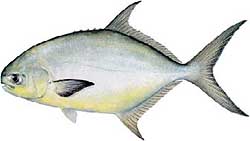 Pompano
can be caught nearshore in the "first
trough or outside the sandbars, as they
search for their favorite food,
sandfleas. Maximum size is about 8 lbs
with their average being about 1 1/2 to
2 lbs. Great eating, and size and bag
limits apply.Click
here for current fishing regulations. Pompano
can be caught nearshore in the "first
trough or outside the sandbars, as they
search for their favorite food,
sandfleas. Maximum size is about 8 lbs
with their average being about 1 1/2 to
2 lbs. Great eating, and size and bag
limits apply.Click
here for current fishing regulations. |
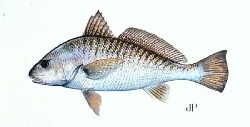 Atlantic
Croaker are a small relative to the
Black Drum and can be caught on the
bottom using cut shrimp, clams, and sand
fleas on a size 2 hook. Jigs tipped with
cut shrimp will also work. The average
size is under a pound with the maximum
being about 3-4 pounds. They are good
eating and are not regulated. Atlantic
Croaker are a small relative to the
Black Drum and can be caught on the
bottom using cut shrimp, clams, and sand
fleas on a size 2 hook. Jigs tipped with
cut shrimp will also work. The average
size is under a pound with the maximum
being about 3-4 pounds. They are good
eating and are not regulated. |
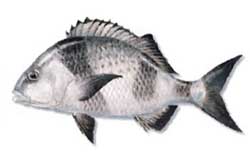 Margate
are a round, thick bodied fish that
primarily like to hang out near some
sort of structure such as the coquina
reefs of the Central Space Coast area,
though they are also caught over sandy
bottoms as well. Average size is about a
pound and can grow to ten pounds. Cut
shrimp, clams, and sand fleas are the
best baits on a size #1 or #2 hook. Good
eating, not regulated Margate
are a round, thick bodied fish that
primarily like to hang out near some
sort of structure such as the coquina
reefs of the Central Space Coast area,
though they are also caught over sandy
bottoms as well. Average size is about a
pound and can grow to ten pounds. Cut
shrimp, clams, and sand fleas are the
best baits on a size #1 or #2 hook. Good
eating, not regulated |
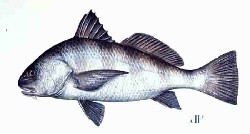 Black
Drum are usually found in the surf
near some sort of structure but can also
be caught over sand bottoms as well.
They can range up to 110 lbs but the
average is much smaller. Drum can be
good eating but the quality drops off
once the fish grows beyond about 5
pounds. Size and bag limits apply.
Click here for current fishing
regulations. Black
Drum are usually found in the surf
near some sort of structure but can also
be caught over sand bottoms as well.
They can range up to 110 lbs but the
average is much smaller. Drum can be
good eating but the quality drops off
once the fish grows beyond about 5
pounds. Size and bag limits apply.
Click here for current fishing
regulations. |
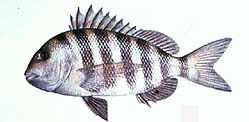 Sheepshead are another species that
prefer structure, and commonly eat small
crabs, barnacles, small bivalves and
other creatures found attached to
structure. Occasionally found over sand
bottoms. Good eating and size and bag
limits apply.
Click here for current fishing
regulations..
Sheepshead are another species that
prefer structure, and commonly eat small
crabs, barnacles, small bivalves and
other creatures found attached to
structure. Occasionally found over sand
bottoms. Good eating and size and bag
limits apply.
Click here for current fishing
regulations.. |
 Bluefish
are one of the more popular surf
fishing species. Traveling in schools
they can be voracious feeders, gorging
themselves on baitfish and striking
nearly anything cast to them. Best baits
are cut mullet and finger mullet. Size
and bag limits apply.
Click here for current fishing
regulations Bluefish
are one of the more popular surf
fishing species. Traveling in schools
they can be voracious feeders, gorging
themselves on baitfish and striking
nearly anything cast to them. Best baits
are cut mullet and finger mullet. Size
and bag limits apply.
Click here for current fishing
regulations |
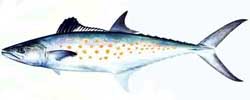 Spanish
Mackerel prefer clean clearer
water and can be seen chasing mullet
and glass minnows in the surf. Will
take live finger mullet, live
shrimp, spoons and plugs. Not often
caught on dead bait. Size and bag
limits apply.
Click here for current fishing
regulations Spanish
Mackerel prefer clean clearer
water and can be seen chasing mullet
and glass minnows in the surf. Will
take live finger mullet, live
shrimp, spoons and plugs. Not often
caught on dead bait. Size and bag
limits apply.
Click here for current fishing
regulations
|
 Redfish
often patrol the surf, particularly
during baitfish migrations and can be
caught on finger mullet, shrimp, crabs,
and virtually any chunk of fish such as
a croaker, etc. Also will take plugs,
spoons, and jigs. They can reach about
50 lbs. but the average is smaller. Size
and bag limits apply.
Click here for current fishing
regulations Redfish
often patrol the surf, particularly
during baitfish migrations and can be
caught on finger mullet, shrimp, crabs,
and virtually any chunk of fish such as
a croaker, etc. Also will take plugs,
spoons, and jigs. They can reach about
50 lbs. but the average is smaller. Size
and bag limits apply.
Click here for current fishing
regulations |
 Snook
can be caught along the beaches,
particularly the beaches from the Indian
Harbor Beach area south to Sebastain
Inlet. They will eat live shrimp,
croakers, pinfish, and readily take
jigs, plugs, and other lures in the
surf. Always use a fluorocarbon leader
when targeting snook as they have an
abrasive mouth as well as razor sharp
gill plates that can also cut your hand
if improperly handled (been there, done
that). Strong fighters when hooked and
will often jump. They can reach about 50
pounds with the average being 5 or 6
pounds. Snook are a subtropical to
tropical species and cannot tolerate
cold water so the best fishing will be
summer and fall. Great on the table!
Closed seasons (Catch and Release) and
slot limits apply. A"Snook Tag" must be
purchased to keep one.
Click here for current fishing
regulations. Snook
can be caught along the beaches,
particularly the beaches from the Indian
Harbor Beach area south to Sebastain
Inlet. They will eat live shrimp,
croakers, pinfish, and readily take
jigs, plugs, and other lures in the
surf. Always use a fluorocarbon leader
when targeting snook as they have an
abrasive mouth as well as razor sharp
gill plates that can also cut your hand
if improperly handled (been there, done
that). Strong fighters when hooked and
will often jump. They can reach about 50
pounds with the average being 5 or 6
pounds. Snook are a subtropical to
tropical species and cannot tolerate
cold water so the best fishing will be
summer and fall. Great on the table!
Closed seasons (Catch and Release) and
slot limits apply. A"Snook Tag" must be
purchased to keep one.
Click here for current fishing
regulations. |
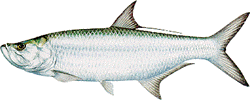 Tarpon
can be found along the beaches,
especially when the mullet are running.
They will attack topwater and subsurface
plugs, spoons, jigs, and soft baits.
Shrimp, mullet, and other live baits
also work. They will also take dead fish
off of the bottom. However, when the
mullet are actively running along the
beaches it is probably better to "match
the hatch", ie, either use live mullet
or artificials that resemble mullet or
at least baitfish such as spoons and
plugs. These fish have very tough mouths
to set a hook in and do require the use
of a fluorocarbon leader. The best areas
to try are the beaches near Sebastain
Inlet. Not much food value but a "Tarpon
Tag" is required if you want to keep one
for mounting.
Click here for current fishing
regulations. Tarpon
can be found along the beaches,
especially when the mullet are running.
They will attack topwater and subsurface
plugs, spoons, jigs, and soft baits.
Shrimp, mullet, and other live baits
also work. They will also take dead fish
off of the bottom. However, when the
mullet are actively running along the
beaches it is probably better to "match
the hatch", ie, either use live mullet
or artificials that resemble mullet or
at least baitfish such as spoons and
plugs. These fish have very tough mouths
to set a hook in and do require the use
of a fluorocarbon leader. The best areas
to try are the beaches near Sebastain
Inlet. Not much food value but a "Tarpon
Tag" is required if you want to keep one
for mounting.
Click here for current fishing
regulations. |
|
Top |
|
|